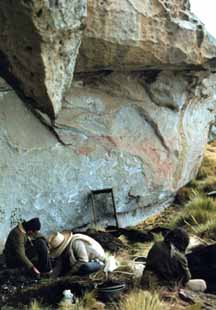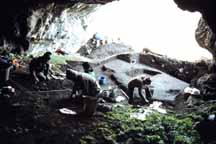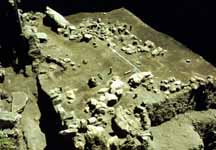excavations

To understand prehistoric puna peoples, John Rick and his students at Stanford University worked together in a long-term archaeological project that excavated a number of cave sites in the Department of Junin, in central Peru. The excavation of these archaeological sites was a complex project, involving much more than simply digging up
artifacts and bringing them home to look at. The physical excavation is only a small part of the work that goes into the effort of reconstructing what life was like for
people thousands of years ago. Many methods of physical and chemical analysis and detailed examination of artifacts produce enormous amounts of statistical data that must all come together to form a basic picture of what happened so long ago.
 Still, the first step is almost always performing the excavation itself. This must be done meticulously to accurately document the very artifact-rich and detailed levels of cave sites.. The artifacts must not only be unearthed, but their original locations and
many other observations must be recorded in great detail. In places like the puna, where sites yield amazingly dense quantities of artifacts, this can be a huge and time-consuming task.
Still, the first step is almost always performing the excavation itself. This must be done meticulously to accurately document the very artifact-rich and detailed levels of cave sites.. The artifacts must not only be unearthed, but their original locations and
many other observations must be recorded in great detail. In places like the puna, where sites yield amazingly dense quantities of artifacts, this can be a huge and time-consuming task.
 In the puna, most of the camps where people lived were in
caves, probably because these locations offered shelter from puna winds, and a local environment buffered against the bitterly cold puna nights. Caves are focus for archeaological investigation and excavation. Pachamachay is a cave near lake Junin at 4,300 meters (nearly 14,000 ft) altitude that probably began to serve as a base camp between 8,000 and 12,000 years ago. By around 8000 years ago the hunter-gatherers who occupied this, and other puna caves had learned a great deal about how to use puna resources. Sometime after 4000 years ago the people of the puna started to make pottery, and gradually shifted from hunting to herding as their primary way of making a living.
In the puna, most of the camps where people lived were in
caves, probably because these locations offered shelter from puna winds, and a local environment buffered against the bitterly cold puna nights. Caves are focus for archeaological investigation and excavation. Pachamachay is a cave near lake Junin at 4,300 meters (nearly 14,000 ft) altitude that probably began to serve as a base camp between 8,000 and 12,000 years ago. By around 8000 years ago the hunter-gatherers who occupied this, and other puna caves had learned a great deal about how to use puna resources. Sometime after 4000 years ago the people of the puna started to make pottery, and gradually shifted from hunting to herding as their primary way of making a living.
 In Pachamachay, the project recognized 33 superimposed layers of undisturbed occupation deposits. In each layer there is a huge amount of data first to uncover, and then to evaluate. The small excavated area in this site alone
contained around 15,000 chert tools, thousands of carbonized seeds and animal bones, hundres of pounds of stone-tool waste. As you can see, there is a staggering quantity of evidence to deal with even from these early time periods.
In Pachamachay, the project recognized 33 superimposed layers of undisturbed occupation deposits. In each layer there is a huge amount of data first to uncover, and then to evaluate. The small excavated area in this site alone
contained around 15,000 chert tools, thousands of carbonized seeds and animal bones, hundres of pounds of stone-tool waste. As you can see, there is a staggering quantity of evidence to deal with even from these early time periods.
|